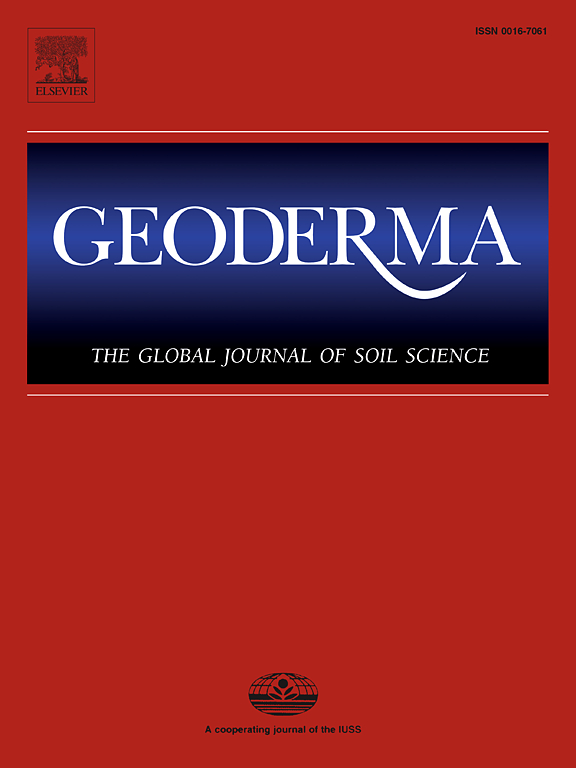The diversity, composition and potential function of bacterial size fractions from maize and soybean farmland soils
IF 5.6
1区 农林科学
Q1 SOIL SCIENCE
引用次数: 0
Abstract
Agricultural soil microbiomes, with their varied cell sizes and metabolic capabilities, contribute significantly to differences in soil ecosystem functions and services. However, the relationships among bacterial cell size, community structure and nutrient turnover in agricultural soils remain unclear. This study categorized bacterial cells from maize and soybean fields into five distinct size fractions—F1 (>10 μm), F2 (3–10 μm), F3 (1–3 μm), F4 (0.4–1 μm) and F5 (0.2–0.4 μm)—using polycarbonate membrane filtration. High-throughput sequencing of the 16S rRNA gene and soil incubation subsequently revealed the taxonomic composition and potential functions of each size fraction. The results indicated that the bacterial diversity in maize field soil was greater than that in soybean field soil, with the F4 size fraction exhibiting the highest diversity and abundance in both soils, whereas the F1 size fraction showed the lowest. Proteobacteria dominated across all size fractions, and size-specific taxonomic distributions were observed: Myxococcota, Entotheonellaeota and Cyanobacteria were enriched in F1 and F2; Planctomycetota and Chloroflexi were enriched in F3; Bacteroidota, Verrucomicrobiota, Actinobacteriota and Firmicutes were enriched in F4 and F5. Before incubation, the qPCR of functional genes showed that the F1–F3 fractions exhibited highly active ammonia oxidation (F1, F2) and ammonification (F3), while the F4 fraction presented highly efficient organic P mineralization, when compared to other fractions. After incubation, qPCR and soil property analyses revealed that the F4 fraction exhibited highest increase in cell numbers and regulated C and P turnover through the secretion of BG and AKP, whereas the F1 fraction consistently maintained high ammonia oxidation capacity. These findings illustrate that bacterial taxa vary in cell size and nutrient turnover processes under different land-uses, thereby deepening our understanding of the bacterial ecology in farmlands.

玉米和大豆农田土壤细菌大小组分的多样性、组成及潜在功能
农业土壤微生物群具有不同的细胞大小和代谢能力,对土壤生态系统功能和服务的差异起着重要作用。然而,农业土壤中细菌细胞大小、群落结构与养分周转之间的关系尚不清楚。本研究采用聚碳酸酯膜过滤技术,将玉米和大豆田间的细菌细胞分为5个不同大小的片段:f1 (>10 μm)、F2 (3-10 μm)、F3 (1-3 μm)、F4 (0.4-1 μm)和F5 (0.2-0.4 μm)。通过16S rRNA基因的高通量测序和土壤培养,揭示了各大小片段的分类组成和潜在功能。结果表明,玉米田土壤细菌多样性高于大豆田土壤,其中F4级土壤细菌多样性和丰度最高,F1级土壤细菌多样性和丰度最低。变形菌门在各大小段均占主导地位,且具有大小特异性的分类学分布:黏菌门(Myxococcota)、Entotheonellaeota和蓝藻门(Cyanobacteria)在F1和F2中富集;F3富集了plantomycetota和Chloroflexi;F4和F5富集拟杆菌门、Verrucomicrobiota、放线菌门和厚壁菌门。孵育前功能基因qPCR结果显示,F1 - F3组分较其他组分表现出较强的氨氧化(F1, F2)和氨化(F3)活性,F4组分较其他组分表现出较强的有机磷矿化活性。孵育后,qPCR和土壤性质分析表明,F4部分细胞数量增加最多,并通过分泌BG和AKP调节C和P的周转,而F1部分始终保持较高的氨氧化能力。这些发现说明了不同土地利用方式下细菌类群在细胞大小和养分周转过程上的差异,从而加深了我们对农田细菌生态的认识。
本文章由计算机程序翻译,如有差异,请以英文原文为准。
求助全文
约1分钟内获得全文
求助全文
来源期刊

Geoderma
农林科学-土壤科学
CiteScore
11.80
自引率
6.60%
发文量
597
审稿时长
58 days
期刊介绍:
Geoderma - the global journal of soil science - welcomes authors, readers and soil research from all parts of the world, encourages worldwide soil studies, and embraces all aspects of soil science and its associated pedagogy. The journal particularly welcomes interdisciplinary work focusing on dynamic soil processes and functions across space and time.
 求助内容:
求助内容: 应助结果提醒方式:
应助结果提醒方式:


